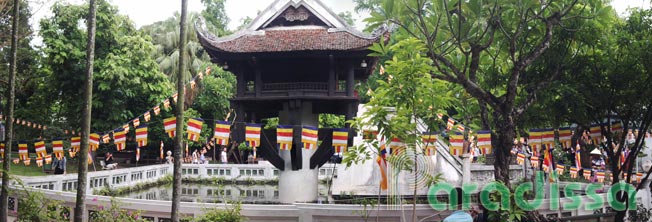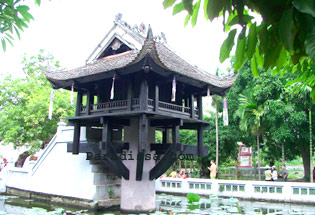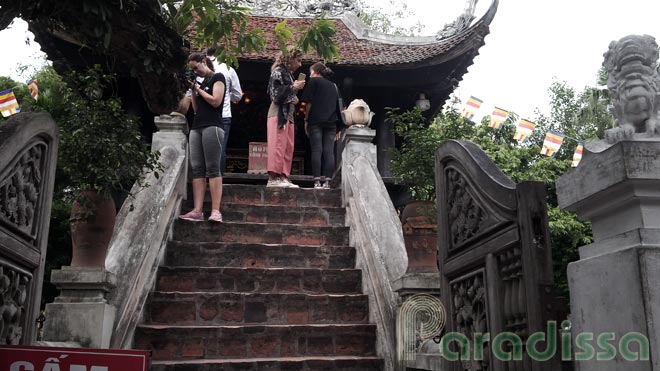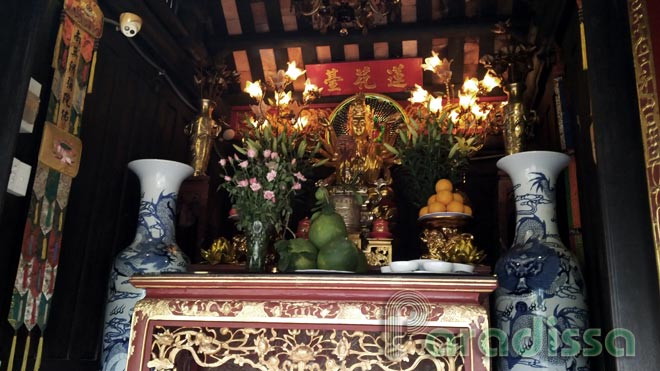Hanoi Holiday Weather today
Date/time of update: July 12, 2025, 12:04 am, Timezone: GMT+7
Mist
Temperature: 26.03°C
Temperature feels like: 26.03°C
Minimum Temperature: 26.03°C
Maximum Temperature: 26.03°C
Atmospheric pressure: 1003hPa
Humidity:94%
Visibility: 5000m
Wind speed: 2.57m/sec
Wind Direction: 290 degrees
Cloudiness: 40%
Sunrise: 2025-07-11 10:22:05
Sunset: 2025-07-12 11:41:38
The One Pillar Pagoda (also known as Dien Huu or Lien Hoa Dai) is located near Ho Chi Minh’s Mausoleum in Hanoi. The site was originally in the Royal Garden when the pagoda was first built.
Travel Guide to the One Pillar Pagoda in Hanoi
According to Dai Viet Su Ky Toan Thu (The Complete History of Dai Viet), the One Pillar Pagoda in Hanoi was built in 1049 by King Ly Thai Tong. The King had a dream that the Goddess of Mercy took his hand and led him to a lotus flower pond. He told his mandarins about this and was told it was unusual, unclear in meaning, possibly an ill omen.

A panoramic view of the One Pillar Pagoda in Hanoi, Vietnam
Then the King was advised by a Buddhist monk named Thien Tue, who had got to a certain level of enlightenment, to build a pagoda dedicated to the Goddess of Mercy. The whole structure like a huge lotus flower is rested on a single stone pillar in a square-shaped lotus flower pond just like what he saw in his dream.
The site of the pagoda was in the Royal Garden, west of the Thang Long Royal Citadel.
After the pagoda was constructed, the King would have Buddhist monks to go around the pagoda reciting Buddhist sacred words to bring him good fortune and longevity, hence the name “Dien Huu” - the official name of the One Pillar Pagoda. “Dien Huu” means “Forever Auspicious”.
The old pagoda was restored several times and was totally destroyed totally by explosive set by the French on 11-September-1954 when they withdrew from Hanoi concluding the First Indochina War. The current pagoda was rebuilt in 1955.
Related to the explanation as to the origin and meaning of the One Pillar Pagoda, there are different sources:
- Epitaph of Van Bia Dai Viet Quoc Ly Gia De Tu De – Sung Thien Dien Minh Thap Bi (Epitaph of the Dai Viet Kingdom, Ly Family, The Fourth King) in 1121 under King Ly Nhan Tong. The epitaph says clearly about the restoration work in 1105-1106 as well as description of the Dien Huu Pagoda.
- Dai Viet Su Ky Toan Thu (The Complete History of Dai Viet, 1697), the most complete officially accepted history of Vietnam throughout the Vietnamese history. The above explanation in this article is by this set of books.

Staircase to the altar
- A less accepted explanation is the Epitaph in 1665 by a Buddhist Monk named Ti Khuu Le Tat Dat says there had been a One Pillar Pagoda at the site in 860 A.D already. Vietnam was ruled by the Chinese Tang Dynasty. King Ly Thanh Tong, who did not have a prince, came to the pagoda and prayed often. One night he had a dream that he was led to a pavilion by the Goddess of Mercy who put a baby into his lap. Then, the Queen was pregnant and a prince was born after.

Quan Am Bo Tat
This epitaph is in conflict with the much earlier epitaph in 1121 and another earlier poem by a famed Buddhist Monk Thien Su Huyen Quang (1254-1343) who described the beauty of the Dien Huu Pagoda in one of his poems.
Hanoi Average Monthly Rainfall and Temperatures
